Effects of Eucalyptus camaldulensis Woodlot Plantation Expansion on Food Security in South Achefer District, West Gojjam, Amhara Region, Ethiopia
Abstract
Eucalyptus camaldulensis is commonly planted on farmland in highland Ethiopia because of its high economic profitability. However, the expansion of woodlot plantations has led to a decline in crop growth and yield, which negatively affects food security. To address this issue, this study aimed to examine the effects of Eucalyptus camaldulensis woodlot expansion on crop production and food security in South Achefer. Data were collected from 180 respondents using a three-stage sampling technique for the four kebeles in the district. The survey data were analyzed using descriptive and inferential statistics, and a binary logit regression model using SPSS software version 24. This study found that most households (87%) perceived a rapid increase in Eucalyptus woodlot expansion. The allocation of more land for Eucalyptus woodlot expansion was positively and significantly affected by family size, landholding size, total annual income, and availability of unproductive land. Additionally, the study revealed that Eucalyptus woodlots highly compete with nearly all grown crops for nutrients and moisture. This causes a reduction in yield from one to four quintals compared to the normal crop grown far from the Eucalyptus tree. Approximately three-fourths (71%) of the sampled farmers did not obtain stable food annually and were considered food insecure. To alleviate food insecurity, this study suggests that stakeholders should focus on improving livelihood alternatives rather than expanding Eucalyptus woodlots.
1. Introduction
Eucalyptus, a rapidly growing tree species native to Australia, has been widely introduced in various regions of the world, including Ethiopia. Its adaptability to different altitudes and its economic benefits have made it a popular choice for afforestation and plantation development in the country’s highlands Dessie, Abate, and Mekie [1].
Eucalyptus is widely cultivated in Ethiopia’s highlands, particularly in regions between 1500 and 3200 m.a.s.l., due to favorable moisture and temperature conditions. The two main species, E. camaldulensis and E. globules, thrive at different altitudinal zones [2]. Smallholder farmers have expanded Eucalyptus woodlots across various landscapes, including farmlands and villages, because of their rapid growth and economic benefits, such as building materials, fuelwood, and charcoal [1]. Additionally, they can contribute to environmental conservation by sequestering carbon and preventing soil erosion [3]. However, the rapid growth and extensive root systems of Eucalyptus can also have negative effects. They can compete with neighboring crops for resources such as water and nutrients, and their dense shade can inhibit the growth of other plants [4].
Food security in Ethiopia, where a significant portion of the population faces food insecurity due to factors such as land degradation and high prices of staple food crops, is a critical concern [5]. The expansion of Eucalyptus plantations raises concerns about their potential impact on food security, particularly in regions with limited agricultural land. As more land is converted to Eucalyptus woodlots, the area available for crop production decreases. This can lead to reduced yields of staple crops and contribute to food insecurity [6, 7].
South Achefer, one of the districts in West Gojjam zone, Amhara region of Ethiopia, has experienced significant expansion of Eucalyptus camaldulensis plantations [8]. This has raised concerns about local food security as arable land is being transformed into Eucalyptus woodlots [9]. The displacement of fertile croplands can have a direct impact on the livelihoods of smallholder farmers who rely on agriculture for their subsistence [10].
While previous studies have explored various aspects of Eucalyptus cultivation in Ethiopia [3, 11–16], there is a significant lack of research specifically examining the effects of Eucalyptus plantations on cereal crop yields and overall food security in affected communities. This study aims to address the existing knowledge gap by conducting a comprehensive investigation of the multidimensional impacts of Eucalyptus woodlot expansion on local agriculture and food security in South Achefer. By providing in-depth insights, this research can contribute to the development of strategies that balance economic development with the preservation of agricultural productivity and food security in Ethiopia’s highlands.
2. Materials and Methods
2.1. Description of the Study Area
The study was conducted in the South Achefer district, which is situated in the West Gojjam zone of northwest Ethiopia, located between 11°19′ 0″ and 11° 29′ 0″ N latitude and 36° 51′ 30″ and 37° 5′ 0″ E longitude (Figure 1). It is approximately 502 km north of the capital city Addis Ababa and 62 km from the regional capital city Bahir Dar. The district’s elevation is approximately 1800 m above sea level, with an average rainfall of 1000–2000 mm and a mean monthly temperature of 180°C. The district experiences erratic and torrential rainfall through a unimodal pattern that begins in mid-April and ends abruptly in late September. The district’s topography comprises gorges, rugged terrain (7%), mountains (8%), and plains (85%). According to the South Achefer District Agricultural Office in 2020, the district has two agroecology namely Woina dega (mid-highland) (87%) and kola (lowland) (13%).
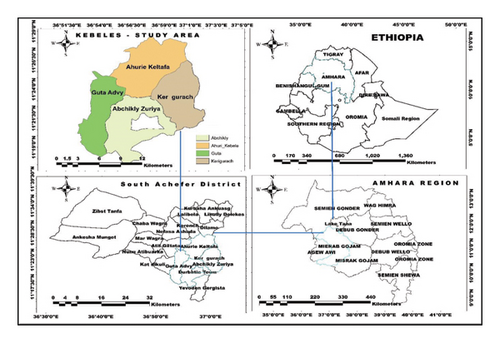
According to the South Achefer District Agricultural Office (2020), the district has two primary towns with a combined population of 43,578 individuals. This population comprised 21,640 males and 21,938 females. The rural population consisted of 68,709 males and 71,063 females, totaling 139,772 individuals. The overall population of the study area was 183,350, comprising 90,349 males and 93,001 females. The district spans approximately 118,228 ha, with 39,195 ha designated as arable land, 18,018 ha used for grazing, and the remaining land used for other purposes. The district soil types were categorized into three groups: 50% red soil, 40% brown soil, and the remaining black soil. These soils are highly productive for the growth of cereal crops, fruits, and vegetables.
2.2. Research Strategy and Design
A mixed-methods survey design employed both quantitative and qualitative approaches. This was done to corroborate the data collected from the quantitative household survey, which utilized both quantitative and qualitative methods when gathering information. Therefore, the data obtained from the FGD and KI interviews served as supplementary information for the survey. This study aimed to verify the influence of Eucalyptus woodlot plantations on cultivated land and food security.
2.3. Sampling Techniques and Size
This study employed a three-stage sampling process to select households for the sample. Initially, the South Achefer district was intentionally chosen because of its extensive Eucalyptus camaldulensis woodlot plantations. Next, four kebeles were picked from the district’s 19 rural and two urban kebeles, based on their significant production of Eucalyptus camaldulensis woodlots, with guidance from district experts. The selected kebeles were Abchikly, Kerigurach, Ahuri, and Guta. Finally, in the third stage, households within these kebeles were chosen randomly using a lottery method. This list of households was compiled with the assistance of local government kebele leaders and developmental agents.
Based on the formula, 180 respondents were sampled from 4074 households, including 147 male-headed and 33 female-headed households, maintaining a 7.3% precision level. Table 1 presents the distribution of the sample among the selected kebeles and households.
| Kebele | Total population | No. of households | No. of sample households |
|---|---|---|---|
| Ahuri | 5346 | 1637 | 75 |
| Abchikly | 4688 | 1120 | 50 |
| Kerigurach | 1472 | 936 | 35 |
| Guta | 3875 | 381 | 20 |
| Total | 15,381 | 4074 | 180 |
- Note: Kebele means small administrative unit.
2.4. Data Collection Method
Quantitative and qualitative data were gathered using the major data collection methods of primary and secondary sources.
2.4.1. Primary Data Collection
Primary data were collected from household respondents and community leaders through household surveys/questionnaires, key informant interviews (KIIs), focus group discussions, and direct observations.
2.4.1.1. Household Survey
The questionnaire was designed sequentially and administered to farmers through scheduled interviews that included both structured and semistructured questionnaires with a mix of open- and closed-ended questions (Appendix, Figure A12). The primary purpose of the survey was to gather information on the socioeconomic characteristics of woodlot growers, the reasons behind the establishment and expansion of woodlots, the source of food crops, the quantity of food crop supply, and the eating habits of households. The questionnaires were developed in English and translated into Amharic (the local language) to ensure good communication between the data collector and households.
2.4.1.2. KII
The selected key informants were purposively chosen based on their expertise and position in the community. These informants included district agricultural extension leaders, kebele DAs, elders, and model farmers. Information was collected through open-ended questions designed to gather comprehensive qualitative data on Eucalyptus production and expansion, the impact of Eucalyptus on crop production, and annual production yields. Questions were prepared to obtain sufficient information on all necessary qualitative data.
2.4.1.3. Focus Group Discussion
Focus group discussions were planned to be carried out with a group comprised of five to ten members. The discussion involved nine members selected from four kebeles, with two individuals from each kebele and one facilitator from the central kebele leader. This selected group provided information on the impact of land conversion on food production, woodlot expansion, crop/food availability, the boundary effect of Eucalyptus on crop production, the current income generated from crop production and long-term Eucalyptus woodlots, the supply trend of food crops in the market, access to agricultural inputs, and access to credit for farmers’ security and nutrition trends in the district. The participants in the focus group included elderly individuals, adults, a female composition, and the kebele leader, who could help the group to relate issues in respect to the actual situation of the area (Appendix, Figure A12).
2.4.1.4. Direct Observation
The objective of the field study was to collect information on the expansion of woodlots and the influence of tree species on cereal crops. The direct observation technique was utilized to corroborate data from various sources, and photographs were taken to illustrate certain aspects of the Eucalyptus plantation activities.
2.4.2. Secondary Data Collection
These data were utilized as additional information to reinforce the primary data and to arrive at a well-founded conclusion. Secondary data were gathered from the records of administrative offices and from published and unpublished reports. This process significantly reduces the amount of time typically spent on data collection and, in the case of quantitative data, provides a sufficient and high-quality database.
2.5. Data Analysis
The collected data were entered into a computer and processed using SPSS version 24, a statistical software package for the social sciences. The analysis of the survey data involved descriptive and inferential statistics as well as a binary logistic regression model. Qualitative analysis was applied to focus group discussions and KIIs, and the results were presented in narrative form.
2.5.1. Descriptive Statistics
Descriptive statistics summarized the socioeconomic characteristics of woodlot growers, reasons for establishing woodlots, sources and amounts of food crops, and household eating habits. This included calculating the means, standard deviations, frequencies, and percentages.
2.5.2. Inferential Statistics
Inferential statistics were used to examine the impact of Eucalyptus woodlot plantations on cultivated land and food security, utilizing chi-square tests and p values to compare food security features among the different farmer groups.
2.5.3. The Binary Logit Regression Model
The binary logit regression model analyzed the factors affecting farmers’ decisions to expand Eucalyptus woodlot plantations, treating the decision as a binary outcome (yes/no), and exploring its relationship with various independent variables, such as gender, age, education level, landholding size, and market access.
2.5.4. Four Key Pillars
Four key pillars were considered to assess household food security: availability, accessibility, utilization, and stability. Chi-square tests and p values were used to evaluate differences in food security characteristics among different farmer groups, with chi-square tests identifying associations between categorical and independent variables. Household consumption levels were measured using Household Income and Expenditure Surveys (HIES), which detailed food acquisition through home purchases, food received as payments, and home production. Daily dietary consumption was calculated by converting food items into kilocalories, averaging them over the number of days, and adjusting for the number of adults in the household [18]. Dietary energy adequacy was assessed by comparing the consumption to the minimum daily requirement of 2100 kcal per adult equivalent. Households consuming less than 2100 kcal/day/AE were classified as food insecure, whereas those consuming at least this amount were considered food secure [19]. The Food and Agriculture Organization (FAO) framework for assessing food security includes classification thresholds: food security (greater than 2100 kcal per day), moderate food insecurity (between 1800 and 2100 kcal per day), and severe food insecurity (less than 1800 kcal per day) [20].
2.5.5. Analysis of Regression
Li = it is the odds ratio of log, which is not only linear in Xi other than linear in the parameters.
Xi = a vector of farmer important characteristics to be estimated.
(yi) is if the error term brings in.
The explanatory variables set in the above (X) incorporated at the model were used by other published literature.
2.5.6. Validity and Reliability
The research findings from the sample households were confirmed through focus group discussions and KIIs to boost the validity and reliability of the results. To obtain accurate information about the current situation, the study employed appropriate methods for each surveyed sample respondent. The questionnaire was prepared in English and then translated carefully into the local language to guarantee clarity, minimize bias, and obtain dependable information from the respondent. Therefore, the study’s findings and results were analyzed in light of a review of related literature and previous research studies for generalization purposes.
2.6. The Study Variables
Variables are essential to compile the result and are categorized as dependent and independent variables.
2.6.1. Dependent Variables
This study investigated the impact of allocating more land to plant Eucalyptus woodlots on a household’s food security status. The dependent variables in this study include the household’s production of food, number of periods the production crop covers, access to food from farmers, utilization of food types, and stability of food in the household. These variables are discrete and provide a yes or no response to the allocation of more land to Eucalyptus plants and the food security status of the households. Farmers who have more land allocation to plant Eucalyptus are categorized as dummy (dichotomous) variables that can only be answered with a “yes” or “no” response. Similarly, food security status is also a dummy variable determined by the Household Dietary Diversity Score (HDDS). This assessment measures households’ consumption of food from the 12 groups of food over the last 7 days and their monthly food consumption/calorie intake based on the World Food Programme (WFP) requirements of sufficient food.
They consumed a diverse array of cereal grains, including maize and millet, which provided them with an ample supply of meat, milk, butter, cheese, vegetables, fruits, and all necessary macro- and micronutrients. They consumed approximately 15 kg of food per month, with a caloric intake of approximately 2000 kcal, making their food secure. On the other hand, respondents experienced moderate food insecurity, as they obtained similar amounts of cereal grains, protein sources, and micronutrients, but with a monthly food consumption of 13–14 kg. Some respondents mainly consumed maize cereals mixed with millet and only received meat and fat-related foods on holidays. They did not regularly consume fruits and vegetables, and their food intake was around 10–12.5 kg per month, with a caloric intake of less than 1800 kcal, thus classifying them as food insecure.
2.6.2. Independent Variable
The independent variables have an impact on the dependent variable, and their selection was based on the literature, practical knowledge of the topic, and accessible data. The variables, including sex, age, family size, education level, landholding size, the presence of unproductive land, market access, total annual income, the quantity of Eucalyptus woodlots on the farm, and respondents’ available food consumption strategies and diversification to sustain life, were determined in this study (Table 2).
| Variables | Measurement | Category | Expected sign |
|---|---|---|---|
| Sex | 0 if male, 1 if female | Categorical | −/+ |
| Age | Number of years | Continuous | +/− |
| Family size | Number of family members | Continuous | + |
| Educational level | 0 if illiterate, 1 if literate | Categorical | + |
| Landholding size | Amount of land hold in hectare | Continuous | + |
| Availability of unproductive land | In hectare | Continuous | +/− |
| Livestock ownership | 0 if no livestock, 1 if they have livestock | Categorical | +/− |
| Market access of respondent | 0 if not easy access to market, 1 if they have market access | Categorical | −/+ |
| Total annual income | Total annual income of household in ETB | Continuous | +/− |
| Eucalyptus woodlot size | In hectare | Continuous | +/− |
3. Results and Discussions
3.1. Demographic and Socioeconomic Characteristics of Sampled Households
Table 3 presents the sample households’ key demographic and socioeconomic characteristics. The respondents’ ages ranged from 27 to 76 years, with an average age of 47.31 years. Older farmers are more inclined to cultivate Eucalyptus woodlots in the area as they may face challenges in crop cultivation. According to relevant research [21], Eucalyptus woodlot production is less labor-intensive than crop farming, which supports this trend.
| Continuous variables | ||||
|---|---|---|---|---|
| Explanatory variables | Min | Max | Mean | Std. deviation |
| Age | 27 | 76 | 47.31 | 12.01 |
| Family size | 2 | 11 | 5.79 | 2.16 |
| Total land holding (ha) | 0.00 | 3.75 | 1.29 | 0.84 |
| Categorical variables | ||||
| Explanatory variables | Category of variables | Frequency | Percentage | |
| Sex | Male | 147 | 81.7 | |
| Female | 33 | 18.3 | ||
| Marital status | Single | 0 | 0 | |
| Married | 165 | 91.7 | ||
| Divorced | 5 | 2.8 | ||
| Widowed | 10 | 5.6 | ||
| Level of education | Literate | 26 | 14.4 | |
| Illiterate | 154 | 85.6 | ||
The survey also recorded household sizes ranging from 2 to 11 members, with an average of 5.79 and a standard deviation of 2.16. The average landholding size was between 0.00 and 3.75 ha, with a mean of 1.29 ha. Of the 180 respondents, 81.7% were male, indicating a predominance of male participants in Eucalyptus woodlot cultivation. In terms of marital status, 91.7% of the respondents were married, while divorced and widowed individuals comprised 2.8% and 5.6% of the sample, respectively. Regarding educational attainment, 85.6% of the respondents were illiterate, whereas only 14.4% had completed education up to grade eight or above. This educational profile may help to explain the various situations outlined in Table 3.
3.2. Expansion of Eucalyptus camaldulensis Woodlot Plantation
According to key informants and focus groups, Eucalyptus camaldulensis was initially introduced to South Achefer district during Emperor Haile Selassie’s reign. During that period, plantations spread primarily along grass borders and homesteads, with limited expansion of fertile cropland. During the Derg regime, Eucalyptus was planted along cropland borders. Since 1990, however, farmers in the study area have increasingly established Eucalyptus woodlots. In the early 21st century, the Agricultural Office began cultivating Eucalyptus camaldulensis seedlings in nurseries and distributing them to local farmers who planted them on their lands. This practice was later extended to private growers and covered additional areas in the study region. From 2007 onward, farmers further expanded Eucalyptus plantations into agricultural lands to address fuelwood shortages.
In recent years, there has been a significant increase in Eucalyptus woodlot planting in the study area. As shown in Figure 2, approximately 5.5% of the respondents began planting Eucalyptus before 2007. The rate of Eucalyptus camaldulensis plantation increased by 6.1% from to 2007–2009, 42.5% from to 2010–2012, 53.5% from to 2013–2015, 59.5% from to 2016–2018, and 65% from to 2019–2021. These findings are consistent with those of previous studies in Southern Ethiopia [11, 22], which also reported similar trends in Eucalyptus expansion.
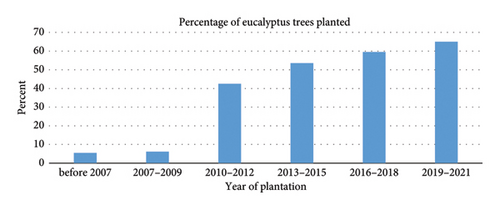
Approximately 87% of the farmers in the study area observed a rapid expansion of Eucalyptus plantations, as shown in Figure 3. However, approximately 11% noted a slower expansion in the past 3 years due to rising crop prices. Many farmers cited the value of Eucalyptus trees as a cash crop and their adaptability to less fertile land as reasons for their increased cultivation.
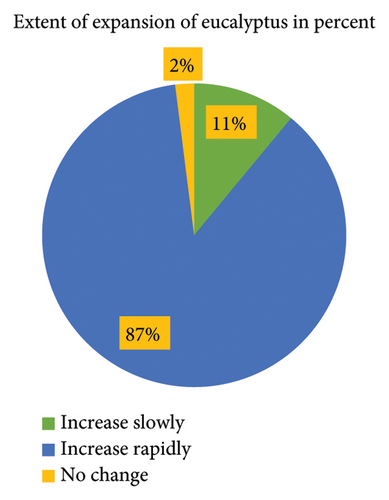
Table 4 indicates that the four sampled kebeles had planted Eucalyptus camaldulensis woodlots on half to one-third of their total farmland. In Abchikly kebele, 1300 ha (56.35%) out of their 2307 ha of total farmland had been planted, whereas in Kerigurach, 454 ha (66.67%) out of their 681 ha of total farmland had been planted; in Ahuri, 920 ha (41.80%) out of their 2200.5 ha of total farmland had been planted, whereas in Guta, 600 ha (50%) out of their 1200 ha of total farmland had been planted. The KII confirmed that the expansion rate of Eucalyptus camaldulensis covered approximately 3274 ha (52.2%) of the fertile cropland.
| Kebele | Total farmland in hectare | Remained farmland | Land covered by Eucalyptus | ||
|---|---|---|---|---|---|
| Hectare | Percent | Hectare | Percent | ||
| Abchikly | 2307 | 1007 | 43.64 | 1300 | 56.36 |
| Kerigurach | 681 | 227 | 33.33 | 454 | 66.67 |
| Ahuri | 2200.5 | 1280.5 | 58.2 | 920 | 41.80 |
| Guta | 1200 | 600 | 50% | 600 | 50 |
| Total | 6388.5 | 3114.5 | 48.75 | 3274 | 51.25 |
As indicated in Table 4, Eucalyptus plantations currently occupy more land than crop production, with approximately 51.25% of the total farmland allocated to Eucalyptus woodlot cultivation, and 48.75% used for crop production. Ongoing efforts to establish new Eucalyptus seedling plantations in the region are highlighted in Appendix Figures A1, A2, A3, and A4. This study aligns with the findings of previous research by [23]. Additionally, a survey revealed that more than half (59%) of respondents dedicated an increasing portion of farmland to Eucalyptus woodlot plantations, as shown in Figure 4.
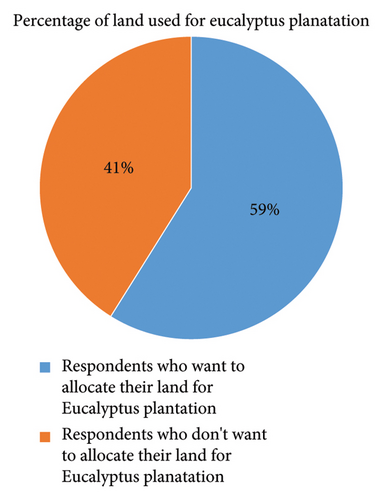
3.3. Prompting Factors for Eucalyptus Woodlot Plantation on Farm Land
The expansion of Eucalyptus plantations among farmers in the study area is driven by a combination of diverse needs and economic incentives. A significant number of farmers, 21.11%, cited the necessity for fuel and construction materials, illustrating how Eucalyptus addresses immediate resource shortages in rural settings. Meanwhile, 31.11% were influenced by the low prices of traditional crops that can be grown in poor fertile soil, prompting a shift toward Eucalyptus as a more profitable alternative. Additionally, 15% of farmers planted Eucalyptus to combat soil fertility issues and utilize unproductive land effectively. The prospect of high income from a single sale, highlighted by 32.78% of respondents, further underscores its economic appeal. Eucalyptus not only meets critical household needs but also offers a promising financial return, thanks to its rapid growth, adaptability to various soil types, and resilience against environmental challenges. This multifaceted approach reflects why Eucalyptus has become a favored choice among farmers, even as the expansion raises important questions about sustainability and environmental impact that must be carefully considered moving forward (see Figure 5).
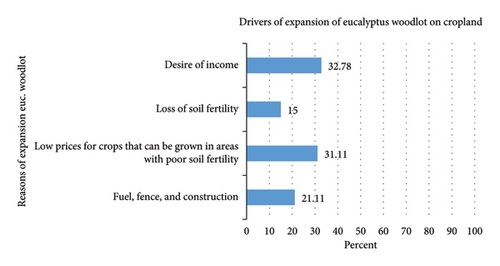
The research findings regarding the shift toward Eucalyptus camaldulensis cultivation are supported by existing studies highlighting the profitability of Eucalyptus over traditional crops like maize and millet. Reference [24] emphasizes that eucalyptus offers higher financial returns, particularly in areas with marginal soil. This aligns with our findings that many farmers are drawn to Eucalyptus due to the low prices of traditional crops. However, there is some disagreement with the finding of other study saying that the steady income from Eucalyptus timber allows farmers to reinvest in higher value crops like teff and wheat, as noted by [22]. This might be due to low fertility of our study area that limited only low price crops like maize and barely to grow.
The growing reliance on Eucalyptus also raises another concerns. Reference [6] warns that as more land is converted to timber plantations, the availability of arable land for food crops decreases, threatening long-term food security. Moreover, [3] highlights the environmental risks, including soil degradation, associated with Eucalyptus plantations. Excessive reliance on Eucalyptus could also undermine agricultural diversification, making farmers more vulnerable to market fluctuations and environmental shocks, as argued by [25]. Therefore, while eucalyptus presents a profitable option in the short term, a balanced approach is needed to ensure both economic sustainability and food security.
Prior to evaluating the logistic regression model, we assessed multicollinearity among the explanatory variables. This was performed by examining four continuous and five discrete variables using the variance inflation factor (VIF) and contingency coefficients (CCs). Our analysis, detailed in Table 5, identified four key variables that significantly influenced the expansion of Eucalyptus woodlots. These variables—family size, landholding size, total annual income, and availability of unproductive land—all had a positive and statistically significant effect on the expansion of Eucalyptus plantations. Conversely, other variables did not have a significant impact on land allocation for Eucalyptus. Specifically, gender (male) and education level had negative coefficients and thus a negative impact, whereas age, livestock ownership, and market access positively influenced the expansion of Eucalyptus woodlots.
| Factor | B | S.E. | Wald | Sig. | Exp (B) |
|---|---|---|---|---|---|
| Gender (1) | −0.592 | 0.579 | 1.046 | 0.306 | 0.553 |
| Age of household | 0.031 | 0.027 | 1.357 | 0.244 | 1.031 |
| Family size | 0.313 | 0.131 | 5.719 | 0.017 ∗∗ | 1.367 |
| Level of education | −0.219 | 0.673 | 0.106 | 0.745 | 0.803 |
| Total land holding size in hectare | 2.134 | 0.464 | 21.169 | 0.000 ∗∗∗ | 8.448 |
| Total annual income | 0.000 | 0.000 | 2.808 | 0.094 ∗ | 1.000 |
| Availability of unproductive land | 0.850 | 0.454 | 3.502 | 0.061 ∗ | 2.339 |
| Livestock ownership | 0.290 | 0.840 | 0.119 | 0.730 | 1.336 |
| Market access | 0.770 | 0.543 | 2.009 | 0.156 | 2.159 |
| Constant | −5.867 | 1.710 | 11.778 | 0.001 ∗∗∗ | 0.003 |
|
|||||
- Note: NS = not significant at p value ≥ 0.1. Note that in the explanatory variable column, the parenthesis represents: Male is a gender category which is not a reference category. The explanatory variables that affect significantly the allocation of more land for the expansion of Eucalyptus woodlot plantation in the study area were conversed as follows.
- ∗, ∗∗, and ∗∗∗Statistically significant at 10%, 5%, and 1% probability level.
3.3.1. Family Size
The size of a farmer’s household significantly influenced the likelihood of allocating more land to Eucalyptus woodlots, with this effect being statistically significant at the 5% level. The coefficient of 1.367 for family size indicates that when all other factors are held constant, an increase in family size increases the odds of a farmer dedicating more land to Eucalyptus woodlots by a factor of 1.367, as detailed in Table 5. This suggests that farmers with larger families are more inclined to expand their Eucalyptus woodlots than those with smaller families. This trend can be attributed to the fact that larger families provide more labor, which facilitates diverse agricultural activities, including tree planting [26]. However, this finding contrasts with a study by [27] conducted in the Jamma district of the South Wollo zone in Ethiopia, which reported a negative correlation between family size and the adoption of Eucalyptus woodlots.
3.3.2. Landholding Size
Land size plays a crucial role in determining farming practices and the allocation of land for planting Eucalyptus woodlots. This study indicates that a farmer’s total landholding size has a positive and highly significant effect on the likelihood of dedicating more land to Eucalyptus woodlots, with a significance level exceeding 0.001%. Specifically, the coefficient of 8.448 for landholding size suggests that holding all other factors constant, each additional hectare of land increases the allocation of Eucalyptus woodlots by a factor of 8.448 (as shown in Table 5). This finding implies that, assuming that other conditions remain unchanged, farmers with larger landholdings are more likely to allocate additional land to Eucalyptus woodlots, particularly if they also have sufficient land to grow food crops. This is in contrast to smaller landholders, who may not have the capacity to expand Eucalyptus plantations.
Previous research supports this notion, showing a positive and significant relationship between farm size and the adoption of Eucalyptus woodlots. For instance, [27, 28] found that an increase in farm size by 1 ha corresponded to a 4.454- and 0.442-fold increase, respectively, in the likelihood of adopting Eucalyptus woodlots. However, the findings of this study diverge from those reported by [29], who observed that in the Basona Worena district of Ethiopia, increased landholding size was associated with a decreased dependency on plantation forests. This discrepancy highlights the need for further investigation of the varying impacts of landholding size on plantation forest dependency across different regions.
3.3.3. Total Annual Income
The results reveal that farmers’ total annual income has a significant positive impact on their likelihood of allocating more land for Eucalyptus woodlot cultivation. Specifically, a 10% increase in total annual income resulted in a substantial increase in the probability of dedicating additional land to Eucalyptus woodlots, with an effect size of 1.000, as detailed in Table 5. This implies that farmers with higher annual incomes are 1.5 times more likely to expand their Eucalyptus woodlots compared to those with lower incomes.
These findings align with previous research, indicating that family income is a crucial factor influencing farmers’ decisions to plant Eucalyptus trees. Consistent with studies in Central Kenya, which found that higher monthly incomes led to increased tree planting and retention, the results support the notion that income positively affects Eucalyptus woodlot allocation [30]. However, this conclusion contrasts with other studies, such as [11], which reported a negative and statistically significant impact of crop production income on the decision to establish Eucalyptus woodlots, with a change of 0.013%. This discrepancy suggests that while a higher total annual income generally encourages Eucalyptus woodlot expansion, income from crop production may have a different influence.
3.3.4. Availability of Unproductive Land
The results indicated that the likelihood of farmers allocating more land to Eucalyptus woodlot plantations is positively associated with the availability of unproductive land, with significance at the 10% level. Specifically, the coefficient of 2.339 for unproductive land suggests that farmers with such land are 2.339 times more likely to dedicate additional land to Eucalyptus woodlots (Table 5). This finding is consistent with [30], who found that the availability of land unsuitable for agriculture significantly motivates farmers to adopt Eucalyptus woodlot plantations. This aligns with the observations of [28, 31], who reported that declining soil fertility increases the likelihood of farmers turning to Eucalyptus woodlots. In contrast, farmers with fertile land prioritize crop production to ensure food security for their families, whereas unproductive land, which is unsuitable for crops, drives the shift toward Eucalyptus woodlot production. However, this study challenges the findings of [32], who suggested that farmers with suitable land are influenced more by the income potential of diverse tree plantations.
3.4. The Effect of Eucalyptus camaldulensis Plantation on Crop Production
Agricultural activities, particularly mixed farming, have traditionally been the primary source of income for surveyed households, with crop production being crucial for both food security and providing essential nutrients [33]. Despite this, recent reports from key informants and focus groups indicate a significant shift from traditional cereal crops and income-generating activities toward monoculture of Eucalyptus woodlots (refer to Figures A10 and A11 in the Appendix). Nevertheless, crop production continues to be a substantial source of income because of its dual role in food and cash generation. The expansion of Eucalyptus woodlots on farmlands has led to changes in crop cultivation patterns. Maize and millet have emerged as the dominant crops, while the cultivation of other crops, such as Teff, wheat, barley, Niger seed, lentils, beans, peas, chickpeas, peppercorns, and flax, has decreased. This transition from crop diversification to Eucalyptus monoculture has negatively affected traditional farming practices in the district [34].
According to the survey data presented in Figure 6, 69% of respondents reported that Eucalyptus trees cause shading on crops, 81% believed they reduce soil moisture, and 67% observed competition for nutrients. While 69% of the respondents agreed that Eucalyptus might decrease soil fertility, over 80% did not perceive it as a source of diseases or pests. Over 80% of the farmers felt that Eucalyptus had an impact on crop yield. These observations are consistent with a previous study by [35] in the Meket district, which found that 85% of farmers believed that Eucalyptus trees consumed more water than native plants. Competition for resources between Eucalyptus and neighboring crops can result in reduced grain yields [36].
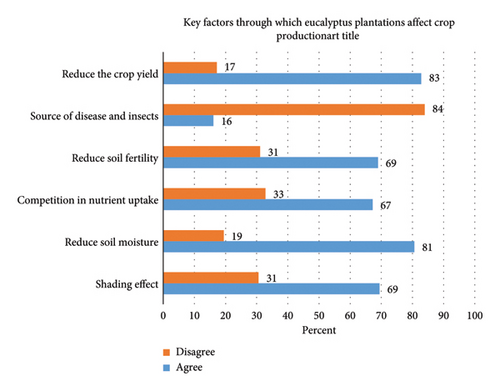
The introduction of Eucalyptus camaldulensis has led to a reduction in land available for crop production. Maize (95.96%), millet (77.77%), and teff (8.89%) were the most important crops for nutrient provision and were integral to the cultivation system (Table 6). To evaluate the impact of Eucalyptus camaldulensis on maize and millet yields and compare the effects across different orientations, both empirical observations and qualitative data are crucial. Research has highlighted two primary adverse effects: nutrient competition and shading. The high water and nutrient uptake of Eucalyptus trees can deplete essential soil nutrients, leading to reduced yields for adjacent crops.
| Crop types | Produce some crop yield | Fail to produce crop yield | Total | Mean | St.D | ||
|---|---|---|---|---|---|---|---|
| Frequency | Percent | Frequency | Percent | ||||
| Maize | 172 | 95.56 | 8 | 4.44 | 180 | 30.3 | 10.84 |
| Millet | 140 | 77.77 | 40 | 22.23 | 180 | 9.6 | 5.69 |
| Teff | 16 | 8.89 | 164 | 91.11 | 180 | 0.62 | 1.53 |
KIIs and focus group discussions corroborate these findings, noting a 3% reduction in maize yields and a 4% reduction in millet yields for east-facing plantations compared to smaller reductions for plantations oriented in other directions (Figure 7). These observations align with those of a previous study [36]. Qualitative data from local experts and farmers further support the view that east-facing plantations have the most pronounced negative effects on crop yields. Empirical data also indicate a 3%–4% yield reduction for crops within a 15-m radius to the east (Appendix, Figures A5, A6, A7, A8, A9, A10), consistent with [37].
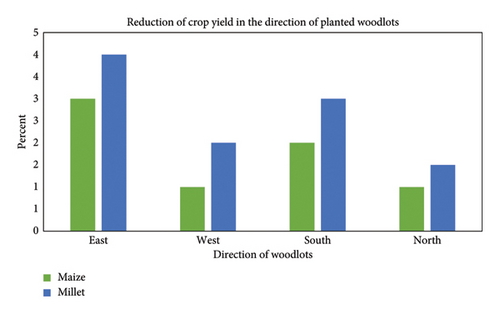
Studies have consistently documented that Eucalyptus adversely affects soil nutrient dynamics, impacting maize and millet yields [38]. Additionally, Eucalyptus plantations can obstruct sunlight, with empirical data showing that east-facing plantations cause the most significant yield reductions. Specifically, east-facing orientations result in a 4% decrease in both maize and millet yields owing to shading, which limits photosynthesis [39].
Overall, comparative analysis revealed that Eucalyptus camaldulensis plantations oriented to the east had the most severe impact on crop yields, primarily due to the combined effects of sunlight blockage and nutrient competition. This conclusion is supported by both the empirical and qualitative data. In contrast, plantations oriented to the south and north had less severe impacts, reflecting variability based on orientation and proximity. Both data types consistently demonstrate that Eucalyptus camaldulensis plantations negatively affect maize and millet yields, with the extent of the impact influenced by the direction of the plantations.
3.5. Effect of Eucalyptus Woodlot Expansion on Food Security Status of the Households
Expanding Eucalyptus camaldulensis woodlots exacerbates food shortages and negatively affects food culture by depleting valuable mineral sources essential for various food and crop types. This expansion has led to ongoing disruptions in the availability, access, utilization, and stability of food resources.
3.5.1. Analysis of Food Availability Dimensions
Food availability encompasses the total quantity of food accessible within a household from various sources, such as domestic production, food stocks, and net trade, as outlined by the WFP. This availability is influenced by factors, such as domestic agricultural output, imports, food reserves, and gifts. A recent survey of 180 farmers revealed that many farmers predominantly cultivating Eucalyptus did not produce sufficient food. Specifically, farmers with Eucalyptus-dominated plots, including both landowners and those renting land, face significant challenges in meeting their annual food needs. The survey data focused solely on farmers who relied on agricultural crop production for food, with no respondents obtaining food through imports or gifts. As shown in Table 7, only 56 households out of 180 produced enough food, which was sufficient for the annual food consumption of the family. Among these, 82.1% cultivated Eucalyptus camaldulensis on up to 0.5 ha, while 17.9% had more than 0.6 ha of Eucalyptus woodlot. Conversely, 114 households grew inadequate food crops (harvested crops), which is sufficient only for family 8–11 months of consumption per year, and 10 households produced no food crops at all. Statistical analysis indicated a significant correlation between the extent of Eucalyptus cultivation and decreased food production, with a p value of 0.05 according to the Pearson chi-square test (X2 = 12.374), suggesting that increased Eucalyptus coverage correlates with reduced annual food output [40].
| Annual food availability | Total | χ2 | df | p value | |||||
|---|---|---|---|---|---|---|---|---|---|
| Failure to produce crops | Growing crops to sustain food needs for 8–10 months | Growing crops to meet annual food needs | |||||||
| Eucalyptus woodlot size in hectare | 0.0–0.5 ha | Count | 6 | 85 | 46 | 137 | 12.374 | 6 | 0.054 |
| % within annual food availability | 60.0% | 74.6% | 82.1% | 76.1% | |||||
| 0.6–1.0 ha | Count | 2 | 20 | 4 | 26 | ||||
| % within annual food availability | 20.0% | 17.5% | 7.1% | 14.4% | |||||
| 1.1–1.5 ha | Count | 1 | 9 | 5 | 15 | ||||
| % within annual food availability | 10.0% | 7.9% | 8.9% | 8.3% | |||||
| 1.6–2.0 ha | Count | 1 | 0 | 1 | 2 | ||||
| % within annual food availability | 10.0% | 0.0% | 1.8% | 1.1% | |||||
| Total | Count | 10 | 114 | 56 | 180 | ||||
| % within annual food availability | 5.6% | 63.3% | 31.1% | 100% | |||||
Focus group discussions further highlighted that limited land availability and the land rental system restricted farmers’ ability to grow the variety of crops needed for annual consumption. Maize, although a staple crop, demands more land for lower yields and significantly limits the diversity of crop farmers. This constraint has led to annual and seasonal food shortages, underscoring the need for improved land management and crop diversification strategies.
3.5.2. Analysis of Food Access
3.5.2.1. Analysis of Households’ Food Access Through Purchasing Power
The increasing population has significantly strained the availability of food crops, leading to a shortfall in meeting household demands. This issue has been exacerbated by the widespread expansion of Eucalyptus woodlots, which have diminished income from traditional food sources. According to the WFP, food access is defined as a household’s ability to consistently acquire an adequate amount of food through various means, including purchases, bartering, borrowing, food assistance, or gifts. There are two primary methods for ensuring household food access: enhancing purchasing power and improving food availability. Currently, a significant proportion of households have limited access to food. The expansion of Eucalyptus woodlots negatively affects food access by reducing household income and purchasing power while also limiting the variety of available food crops, including both grain and nongrain foods.
Households typically obtain food from three sources: home production, market purchases, and labor payments. Data from Figure 8 indicate that only 52 households (30%) were able to regularly purchase an adequate amount of food to meet their needs. Conversely, 70% of the surveyed households experienced challenges with both financial and physical access to food, highlighting varying degrees of food insecurity. This situation is particularly problematic for households that depend on single-crop Eucalyptus-based farming systems, which are vulnerable to price fluctuations and market access issues. Focus group discussions revealed that the high cost of food was largely attributable to households’ limited budgets and incomes, which constrained their ability to buy a diverse range of nutritious foods. This finding aligns with that of a previous study [41].
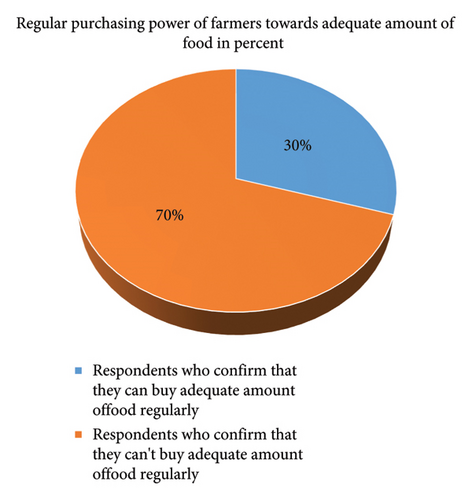
3.5.2.2. Analyze Food Access Through Household Food Insecurity Assessment Survey
The text summarizes the findings of a month-long food insecurity assessment survey that utilized seven standard questions to gauge food access issues among 180 households. Table 8 presents the results, revealing that over half of the households experienced challenges in accessing food. Specifically, 58.3% of households reported difficulties in consuming a diverse range of foods, 80% indicated a reduction in food intake due to scarcity, and 53.3% were unable to enjoy their preferred food. Additionally, 31.1% of households occasionally worried about food shortages, 26% experienced food shortages, and 37.2% had to settle for less preferred food because of financial constraints. Among the farmers in the surveyed area, 34.4% reported sometimes facing difficulties accessing food, leading to a reliance on repetitive food options, while 32.8% reduced their food intake to manage scarcity. This study highlights that the expansion of Eucalyptus woodlot plantations on fertile farmland has significantly affected food security for many farmers in the region [8].
| Measurements | Rarely | Sometimes | Often | Total | |||
|---|---|---|---|---|---|---|---|
| Freq. | Perc. (%) | Freq. | Perc. (%) | Freq. | Perc. (%) | ||
| Worried about not having enough food | 56 | 31.10 | 45 | 25 | 79 | 43.90 | 180 (100%) |
| Inability to eat various favored food | 28 | 15.60 | 47 | 26.10 | 105 | 58.30 | ,, |
| Eat only a limited diversity of food | 7 | 3.90 | 29 | 16.10 | 144 | 80 | ,, |
| Being forced to eat the same food due to lack of food | 39 | 21.70 | 62 | 34.40 | 79 | 43.90 | ,, |
| Suffered food shortage to eat | 48 | 26.70 | 42 | 23.30 | 90 | 50 | ,, |
| Eat less preferred food due to lack of income | 67 | 37.20 | 24 | 13.30 | 89 | 49.50 | ,, |
| Reduce the amount of food to cope with the lack of food | 25 | 13.90 | 59 | 32.80 | 96 | 53.30 | ,, |
- Note: That from the table, severity status on food access; rarely mean (once to twice in 1 month), Sometimes (three to four times in a month), and often (from five to six times in a month).
- Abbreviation: HFIAS = household food insecurity access scale.
3.5.3. Analyze of Food Utilization
The benefits of food consumption are deeply intertwined with proper food processing, effective storage techniques, sound nutritional knowledge, and access to adequate health and sanitation facilities. As highlighted by the World Food Summit, food security encompasses not only the availability of sufficient and secure food to meet dietary needs, but also ensures that this food is safe and nutritious [42]. Effective food security relies on access to safe drinking water and sanitation, which are crucial for preventing waterborne diseases and ensuring overall health [43]. Nutritional knowledge and appropriate food-handling practices are essential to maximize the health benefits of food. According to the FAO, food processing and storage techniques help maintain the nutritional quality of food while reducing waste [44]. Proper storage prevents the growth of pathogens and spoilage, which can significantly affect nutritional intake and food safety [45].
In assessing food utilization, calorie intake serves as a key indicator of the energy required for daily activities. FAO’s 2006 guidelines suggest that the average daily energy requirements are approximately 2500 kilocalories for men and 2000 kilocalories for women, although these figures can vary based on age, activity level, and overall health [46]. Measuring food energy intake typically involves converting food items into kilocaloric values and summing the total consumed by household members (Appendix, Table A1).
The FAO framework for assessing food security includes classification thresholds: food security (greater than 2100 kcal per day), moderate food insecurity (between 1800 and 2100 kcal per day), and severe food insecurity (less than 1800 kcal per day) [20]. Recent findings reveal that 50.6% of households consumed less than 1800 kilocalories, 18.3% consumed between 1800 and 2100 kilocalories, and the remaining consumed more than 2100 kilocalories. Consequently, 50.6% of the households were classified as severely food insecure, 18.3% as moderately food insecure, and 31.1% as food secure (Table 9).
| Calorie availability/adult equivalent/day | Total | χ2 | df | Sig. | |||||
|---|---|---|---|---|---|---|---|---|---|
| FS (≥ 2100 kcal) | MFI (1800 to < 2100 kcal) | SFI (< 1800 kcal) | |||||||
| Eucalyptus woodlot size in hectare | 0.0–0.5 ha | Count | 41 | 25 | 71 | 137 | 8.415 | 6 | 0.209 |
| % within calorie availability/adult equivalent/day | 73.2% | 75.8% | 78.0% | 76.1% | |||||
| 0.6–1.0 ha | Count | 9 | 7 | 10 | 26 | ||||
| % within calorie availability/adult equivalent/day | 16.1% | 21.2% | 11.0% | 14.4% | |||||
| 1.1–1.5 ha | Count | 4 | 1 | 10 | 15 | ||||
| % within calorie availability/adult equivalent/day | 7.1% | 3.0% | 11.0% | 8.3% | |||||
| 1.6–2.0 ha | Count | 2 | 0 | 0 | 2 | ||||
| % within calorie availability/adult equivalent/day | 3.6% | 0.0% | 0.0% | 1.1% | |||||
| Total | Count | 56 | 33 | 91 | 180 | ||||
| % of total | 31.1% | 18.3% | 50.6% | 100.0% | |||||
- Abbreviations: FS = food secure, MFI = moderately food insecure, SFI = severely food insecure.
Although the analysis did not achieve statistical significance at a p value of 0.05 (Pearson chi-square X2 = 8.415), the percentage data suggest a correlation between the expansion of Eucalyptus camaldulensis woodlots and a decrease in the calorie content of available food. This reduction may be attributed to the encroachment of Eucalyptus woodlots on farmland, which potentially reduces annual crop production. This observation is consistent with the research by [47], who investigated the impact of climate variability on household food availability in Tigray, Ethiopia. According to nutritional guidelines from the WFP, the recommended daily calorie intake for adults should include a balanced distribution of food groups: 38% starchy foods, 13% oils and fats, 35% legumes, 4% animal foods, 6% fruits, and 4% nonstarchy vegetables [48]. This balanced intake supports optimal health and helps to prevent deficiencies that can arise from inadequate or imbalanced food consumption. Overall, addressing food security and nutritional adequacy involves a multifaceted approach that integrates proper food processing and storage, the effective utilization of food resources, and access to essential health and sanitation facilities.
3.5.4. Analysis of Food Stability
Food security is determined by the availability, accessibility, and affordability of food in a household. This concept is reflected in Figure 9, which classifies households based on their ability to access stable food consistently. Households that frequently achieve stable food consumption are considered food secure, whereas those that fail to meet one or more of these criteria are deemed food insecure. Among the respondents, 71% (n = 128) did not consistently achieve stable annual food consumption, whereas 29% (n = 52) did.
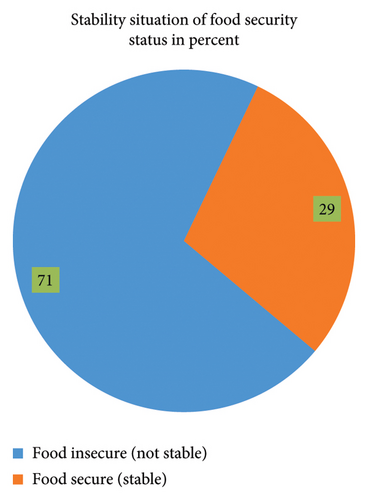
The WFP identifies several key factors contributing to food insecurity, including land use and cover changes, limited market access, fluctuations in food production, insufficient access to improved agricultural inputs, pests, and diseases, high illiteracy rates among household heads, poor health conditions, and inadequate hygiene. These factors can undermine the stability of food supplies and hinder households’ ability to maintain steady income to purchase food.
According to the participants in the focus group discussion, the fluctuating value of money exacerbated food insecurity. Four years ago, 1000 Birr (approximately 18.62 USD) could buy 50 kg of peas, but now it only purchases 22 kg. The income from woodlots is highly variable, depending on factors such as market access, tree age, and performance, and there is no guaranteed annual income. In addition, production is limited to maize and millet, with a restricted variety of options.
A lack of steady income significantly impacts a household’s food security by limiting its ability to purchase essential agricultural inputs and food items. As one participant noted, a higher per capita income enhances a household’s purchasing power, leading to a more diverse and secure food supply. Conversely, poor growth and performance of Eucalyptus trees in local woodlots have led to an oversupply of wood that local buyers do not need. This surplus, coupled with insufficient income, further contributes to food insecurity. These findings are in contrast to those of a previous study [49].
4. Conclusions and Recommendations
Eucalyptus expansion, which began significantly in the 1990s due to free seedlings, now covers 41.8%–66.7% of farmland in the sampled areas. In 2010, 42.5% of households started planting Eucalyptus. The primary drivers were high demand for fuel and construction wood, income generation, and the use of unproductive land, with low crop prices and soil fertility loss. The study used a binary logit regression model to show that a larger family size, more landholding, higher income, and unproductive land significantly influenced Eucalyptus expansion. However, Eucalyptus plantations negatively affected neighboring crop production by reducing soil moisture, shading, and nutrient competition, leading to lower maize and millet yields. This expansion has worsened food security by decreasing household food production and income, with 50.6% of households having insufficient caloric intake, and 71% lacking stable food access.
Recommendations include revising land-use policies to limit Eucalyptus plantations on agricultural land, educating farmers on the negative impacts, and promoting the cultivation of edible crops. Emphasis should be placed on planting Eucalyptus on degraded land and implementing the best practices. Coordinated efforts from extension workers, NGOs, and researchers are needed to develop sustainable solutions to improve food security while balancing economic benefits with environmental and socioeconomic impacts.
5. Further Research Directions
Research on the impact of Eucalyptus camaldulensis woodlot plantations on food security in the South Achefer district, West Gojjam, Amhara Region, Ethiopia, suggests several future studies. These include quantifying the effects on crop productivity, soil fertility, nutrient cycling, water availability, and local livelihoods through field experiments, hydrological studies, and economic analysis. In addition, examining community perceptions, adaptation strategies, and policy interventions using qualitative methods is recommended. Long-term monitoring, modeling, and comparative studies with other land uses are suggested to fully understand the trade-offs and synergies related to Eucalyptus plantations and food security. Addressing these areas can provide valuable insights into the interactions between Eucalyptus plantation expansion and food security, aiding evidence-based decision making and sustainable land management in Ethiopia and similar regions.
Ethics Statement
The ethical guidelines for this research were approved by the Department of Natural Resource Management (approval number 2024/NARM/02), which is part of the College of Agriculture and Natural Resources at the DMU. All participants were informed of the objectives of the study and willingly consented to be interviewed. Written informed consent was obtained from all the participants. Participants were kept anonymous to ensure their privacy.
Conflicts of Interest
The authors declare no conflicts of interest.
Author Contributions
Kiros Getachew Belachew came up with the concept, devised the methods, and collected and analyzed the data. Additionally, he facilitated the data collection process and input the information into the EXCEL and SPSS software for data analysis. He was also responsible for writing the manuscript and receiving feedback from reviewers. Alemu Gashe Desta played a role in editing the study.
Funding
The authors declare that there are no funding or other issues with this manuscript.
Acknowledgments
Our deepest thank goes to Debre Markos University for provision of some required facilities.
Appendix A: The Newly Planted Eucalyptus Seedlings and Its Negative Impact on Nearby Grown Crops
| Food item | Kcal/100 g |
|---|---|
| Teff | 341 |
| Barley | 354 |
| Wheat | 351 |
| Maize | 362 |
| Sorghum | 347 |
| Lentil | 353 |
| Bean | 344 |
| Field peas | 341 |
| Chickpeas | 364 |
| Guaya | 347 |
| Finger millet | 312 |
| Coffee | 2 |
| Sugar | 400 |
| Berbere | 318 |
| Salt | 0 |
| Oil | 884 |
| Onion | 42 |
| Garlic | 149 |
| Potato | 87 |
| Tomato | 18 |
| Milk | 39 |
| Cheese | 132 |
| Beef | 235 |
| Chicken | 140 |
| Egg | 68 |
- Abbreviations: ENHRI = Ethiopian Nutrition and Health Research Institute, WHO = World Health Organization.
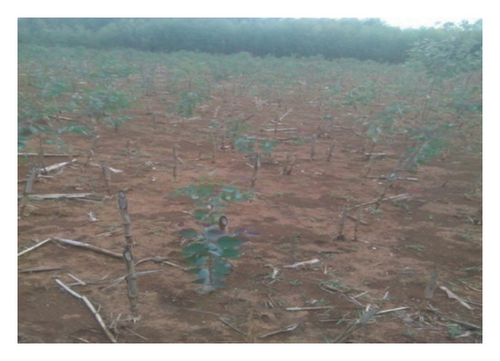
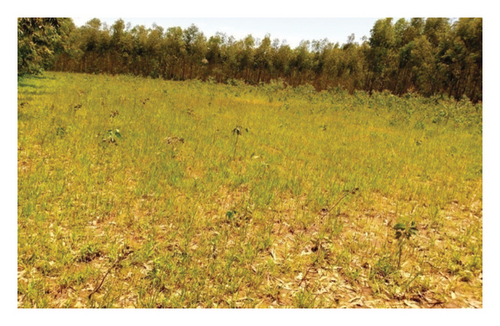
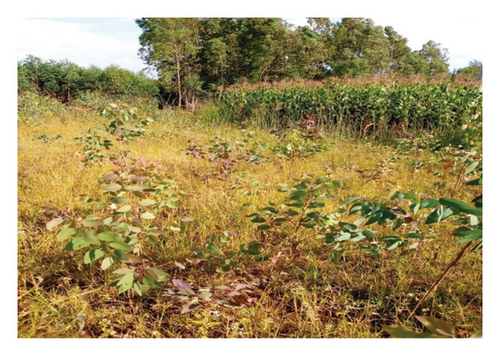
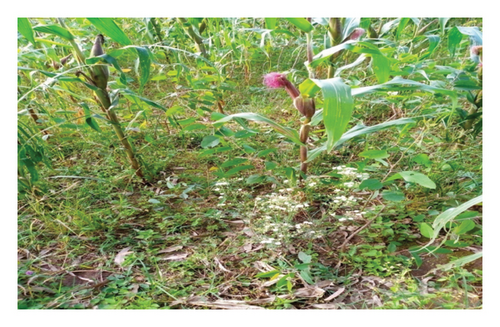
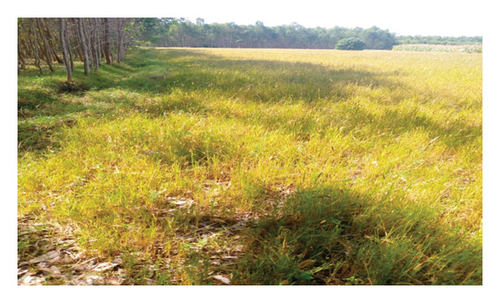
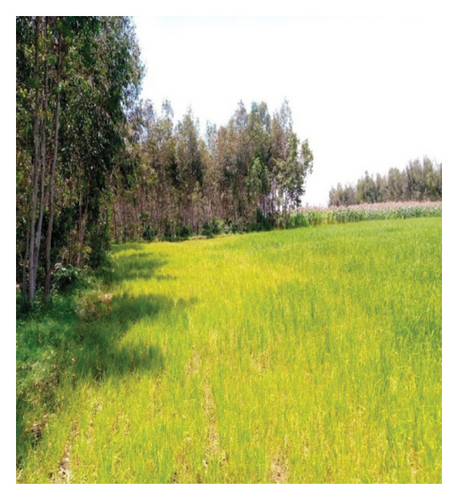
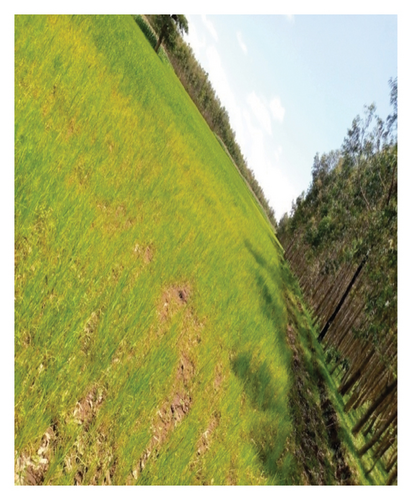
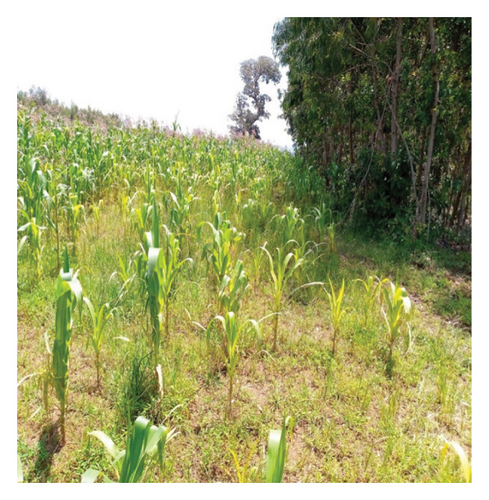
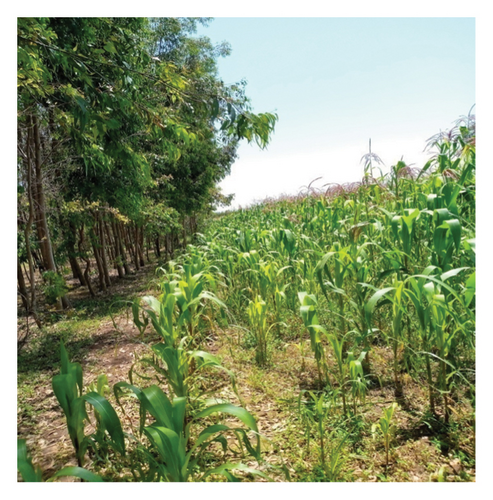
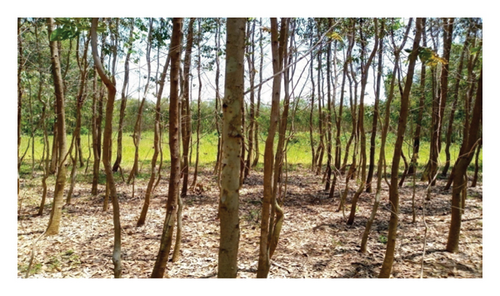
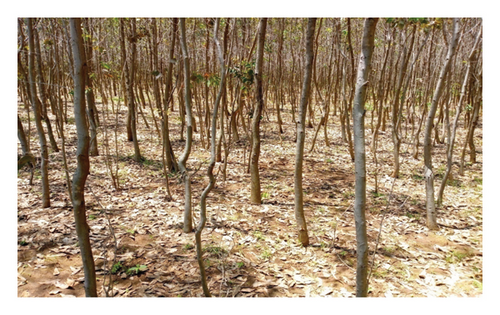
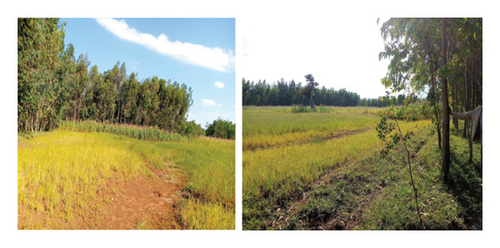


Open Research
Data Availability Statement
The data for this study are available with the researcher and will be shared upon request.




